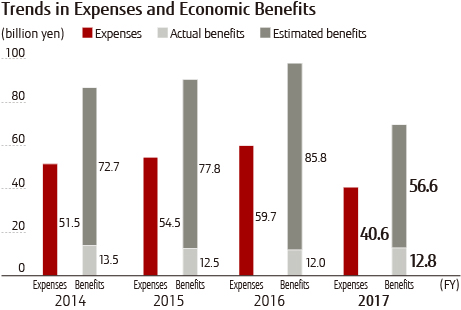Archived content
NOTE: this is an archived page and the content is likely to be out of date.
Environmental Accounting
To promote environmental management, the Fujitsu Group introduced environmental accounting in FY 1998. We evaluate the efficiency of our environmental protection activities by monitoring the required costs and benefits of these activities. Through this process, we have clarified issues and promoted sharing of the results.
Purpose of Introducing an Environmental Accounting System
- To clarify our corporate stance through disclosure of information to stakeholders
- To implement long-term, continuous environmental measures
- To raise the efficiency of investment in environmental protection measures
- To energize environmental protection activities
Basic Environmental Accounting Elements in FY 2017
- Applicable period
April 1, 2017 to March 31, 2018 - Accounting coverage
Fujitsu and its major consolidated subsidiaries worldwide *1 - Calculation basis for environmental protection costs
- Accounting method for depreciation and amortization : Depreciation and amortization expenses for investments are included in expenses using straight line depreciation (with no residual value) based on a useful life of 5 years. The useful life of 5 years was chosen based on the average length of the actual period from the introduction of environmental facilities to the implementation of repairs and upgrades.
- Basis for recording composite costs : In regard to composite costs in which environmental protection costs are coupled with other costs, the Fujitsu Group records only the portion corresponding to environmental protection in conformance with the Environmental Accounting Guidelines 2005 issued by the Japanese Ministry of Environment.
- Calculation basis for the economic benefits of environmental protection measures
- Scope of benefits in environmental accounting : The Fujitsu Group records the actual benefits and estimated benefits (risk avoidance benefit and deemed benefit) of reducing environmental impact related to the following items.
- Benefit of reducing the environmental impact related to resource usage in business activities
- Benefit of reducing the environmental impact related to environmental loads and waste emissions resulting from business activities
- Benefit of reducing the environmental impact related to goods and services produced by business activities
- Benefit of reducing the environmental impact related to transportation and other activities
- Investment benefit materialization period and basis : The accounting period for actual economic benefits has been aligned with the depreciation and amortization period for investments (60 months). However, the accounting period for economic benefits derived from reducing personnel costs related to the environmental management system is 12 months, in line with the main thrust of the environmental management system, which is reviewed every year. With regard to estimated economic benefits, the accounting period for economic benefits derived from capital investment is the same as the depreciation and amortization period (60 months) for actual economic benefits. Benefits corresponding to a given fiscal year, such as the amount of contribution to environmental protection and the avoidance of operational losses, are recorded only for that fiscal year. The basis for accounting for economic benefits is as follows.
- Contribution of environmental protection activities to added value derived from production activities
The Fujitsu Group recognizes support provided by environmental protection activities to production activities as an economic benefit. Accordingly, the amount of contribution is determined by multiplying the added value derived from production activities by the ratio of the maintenance and operation cost for environmental protection facilities to the total facility cost of each site.
Contribution = Added value x Maintenance and operation cost for environmental protection facilities / total facility cost - Avoidance of operational loss at business sites due to non-compliance with laws and regulations
The Fujitsu Group recognizes the avoidance of operational loss as the amount of loss that is avoided in the event of the materialization of risk arising from neglect to make upfront investments needed to comply with laws and regulations. The number of operational loss days is determined based on the size of investment related to the environment, but shall not exceed three days.
Benefit = Added value / Operational days x Operational loss days - Benefit of public relations activities
This benefit is calculated by converting publicity efforts related to environmental protection activities in newspapers, magazines and TV into an advertising cost.
Benefit=Advertising cost of newspapers, magazines and TV x Number of advertisements ran and programs broadcast - R&D benefit
The Fujitsu Group calculates the amount of additional earnings resulting from the contribution of R&D achievements for environmental protection purposes, such as Super Green Products and environmental solutions.
- Contribution of environmental protection activities to added value derived from production activities
- Scope of benefits in environmental accounting : The Fujitsu Group records the actual benefits and estimated benefits (risk avoidance benefit and deemed benefit) of reducing environmental impact related to the following items.
*1 Fujitsu's major consolidated subsidiaries worldwide:
FUJITSU ISOTEC LIMITED, FUJITSU IT PRODUCTS LIMITED, Fujitsu I-Network Systems Limited, Fujitsu Interconnect Technologies Limited, Ecolity Service Limited, FDK CORPORATION, FUJITSU OPTICAL COMPONENTS LIMITED, FUJITSU KASEI LIMITED, FUJITSU CLIENT COMPUTING LIMITED, Fujitsu Laboratories Limited, FUJITSU CONNECTED TECHNOLOGIES LIMITED, FUJITSU COMPONENT LIMITED, Shimane Fujitsu Limited, FUJITSU PERIPHERALS LIMITED, SHINKO ELECTRIC INDUSTRIES CO., LTD., Fujitsu Telecom Networks Limited, Fujitsu Ten Limited (currently DENSO TEN LIMITED), Fujitsu Ten Manufacturing Limited (currently DENSO TEN MANUFACTURING LIMITED), TRANSTRON Inc., PFU Limited, FUJITSU FRONTECH LIMITED, MIE FUJITSU SEMICONDUCTOR LIMITED, AIZU FUJITSU SEMICONDUCTOR WAFER SOLUTION LIMITED, AIZU FUJITSU SEMICONDUCTOR MANUFACTURING LIMITED, Fujitsu Network Communications Inc., FUJITSU TECHNOLOGY SOLUTIONS (HOLDING) B.V.
The Fujitsu Group also aggregates data on R&D costs and benefits related to environmental solutions from subsidiaries other than those shown above. However, the data is aggregated solely for environmental solution costs and benefits, so the relevant subsidiaries are not included in the scope of disclosure for major consolidated subsidiaries.
Fiscal 2017 Environmental Accounting Results
Breakdown of Results (Investment and costs) [billion yen]
| Item | Main areas covered | Capital investment
(billion yen) |
Expenses
(billion yen) |
Economic benefits
(billion yen) |
|
|---|---|---|---|---|---|
| Total | 2.41(+1.07) | 40.64(-19.06) | 69.38(-28.43) | ||
| Business area costs/benefits | Pollution prevention costs/benefits | Air/water pollution prevention, etc. | 2.02(+1.56) | 4.55(-0.14) | 7.67(+1.44) |
| Global environmental conservation costs/benefits | Global warming prevention, saving energy, etc. | 0.25(-0.35) | 2.37(-0.08) | 1.46(-0.02) | |
| Resource circulation costs/benefits | Waste disposal, efficient utilization of resources, etc. | 0.01(-0.10) | 2.27(-0.03) | 10.98(+1.00) | |
| Upstream/downstream costs/benefits | Collection, recycling, reuse, and proper disposal of products, etc. | 0.01(-0.00) | 0.84(+0.02) | 0.36(-0.17) | |
| Administration costs/benefits | Provision and operation of environmental management systems, environmental education of employees, etc. | 0.03(-0.00) | 2.23(-0.41) | 0.30(-0.19) | |
| R&D costs/benefits | R&D on products and solutions that contribute to environmental protection, etc. | 0.09(-0.01) | 28.31(-18.38) | 48.61(-30.49) | |
| Social activity costs | Donations to, and support for, environmental groups, etc. | 0.00(+0.00) | 0.03(-0.01) | - | |
| Environmental remediation costs/benefits | Restoration and other measures related to soil and groundwater contamination, etc. | 0.00(-0.04) | 0.04(-0.03) | 0.00(+0.00) | |
- Numbers in parentheses indicate increases or decreases in comparison with the previous year.
- Due to rounding, figures in columns may not add up to the totals shown.
- Amounts shown as "0.00" include amounts for which the value was smaller than the display units used.
Costs and Economic Benefits in FY 2017
The results of Environmental Accounting for FY 2017 showed expenses of 40.6 billion yen (32% decrease from the previous year), and the economic benefits (calculated by our original estimating method) were 69.4 billion yen (29% decrease from the previous year). Thus both expenses and benefits decreased.
Also, our capital investment was 2.4 billion yen (79% increase from the previous year) by the water pollution prevention measures etc.

Environmental Liabilities
Our Liabilities toward the Environment
The Fujitsu Group, in properly forecasting expected future environmental liabilities and communicating our soundness and stance of not deferring environmental liabilities, has recorded a liability of 4.48 billion yen in soil-pollution cleanup costs, high-level polychlorinated biphenyl (PCB) waste disposal costs, and asbestos processing costs during facilities demolition. This total is the amount we calculate, as of the end of FY 2017, to be necessary for the Fujitsu Group in Japan to carry out these tasks in the next FY and beyond
Past Records
Past records of our environmental accounting up to FY 2016 are included in the Sustainability Report.
